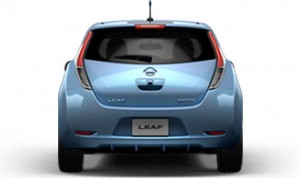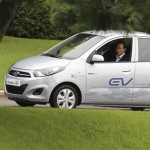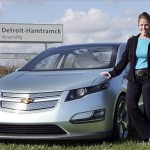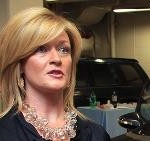$2,500 rebate for electric vehicle buyers in Tennessee
By James Cartledge
Tennessee drivers behind the wheel of a Nissan LEAF could find their bank balance $10,000 better off thanks to federal and state rebates.
balance $10,000 better off thanks to federal and state rebates.
The first 1,000 owners of Nissan LEAF all-electric cars in the state of Tennessee will be eligible for a $2,500 rebate. And, the rebate will come in addition to the $7,500 tax credit available from the federal government for electric vehicle buyers. The state’s Governor, Phil Bredesen, announced the new rebate program yesterday, at an event during which a 425-mile network of electric vehicle charging points was unveiled (see this BrighterEnergy.org story).
The rebate is being funded through a $2.5 million provision in last year’s state budget, which uses funds collected from oil companies, and will be administered by Tennessee’s Department of Revenue. Electric vehicle buyers will have their rebates applied at the time the vehicle is purchased at one of Nissan’s network of Tennessee dealerships. Along with both the state and federal incentives, the price of a five-door, 100-mile-range Nissan LEAF car would drop to as low as $22,780. The vehicle’s original recommended retail price is $32,780.
Key market
Tennessee is one of the key markets identified for early adoption of mass-production electric vehicles like the LEAF, which is being released in the state in December 2010.
It is one of six US states participating in the EV Project, the world’s largest roll-out of electric vehicle charging infrastructure. The state will also be home to a lithium-ion battery production facility set to supply power units for the Nissan LEAF, and a facility to produce the LEAF itself from 2012 (see this BrighterEnergy.org story).
“We’ve worked hard in Tennessee to become a leader in driving clean energy solutions and creating clean energy jobs,” Gov. Bredesen said. “We’re already seeing additional jobs being created as a result of those efforts, and our participation in the Electric Vehicle project is another indication that Tennessee is leading the way to the future of clean energy and alternative fuels.”
Motor manufacturer Nissan said the Tennessee rebate program was “one more step” for the state to a green economy. Brian Carolin, senior vice president of Sales and Marketing for Nissan North America, said: “The state has been a leader in the promotion of zero-emission mobility and is to be commended for creating the right environment for all-electric vehicles like the Nissan LEAF to be an option for consumers in Tennessee.”
Other states that are offering financial incentives for the purchase of an electric vehicle include California, Georgia, Hawaii, Oregon, Washington, Maryland, and South Carolina.
Hyundai shows off SKorea’s first electric car
 By KELLY OLSEN (AP) – 1 day ago
By KELLY OLSEN (AP) – 1 day ago
SEOUL, South Korea — Hyundai Motor unveiled its first electric car Thursday — the BlueOn — as it moves to catch up with Japanese rivals that have jumped ahead in the field.
Hyundai showed off the car on the grounds of Seoul’s hillside Blue House, the office and residence of South Korean President Lee Myung-bak, who took it for a spin while Cabinet ministers, officials and electric-vehicle industry representatives looked on. South Korea’s biggest automaker said that it invested about 40 billion won ($34.3 million) over one year to create the vehicle, which is based on the automaker’s small i10 hatchback.
Hyundai, which hailed the small car as South Korea’s first full-speed electric vehicle, said that it plans to deliver 30 of them on a test basis to various South Korean government organizations by October and plans to manufacture 2,500 by the end of 2012. “We are proud to introduce the world to BlueOn, which was fully developed in Korea and displays Hyundai’s latest technological advancements,” Lee Hyun-Soon, vice chairman at the automaker’s research and development center, said in a release.
“Consumers’ interests and demand for eco-friendly cars are rising and securing such advanced technology is critical in becoming an industry leader,” he said. Hyundai has in recent years won strong reviews for quality and design as it increased market share and brand recognition worldwide, but Japanese rivals have pushed ahead in electric vehicles.
Mitsubishi Motors Corp. already manufactures the iMiEV electric car, while Nissan Motor Co. plans to mass produce its Leaf electric vehicle during this fiscal year.
The 2,500 cars Hyundai plans to produce will include retail sales in South Korea, said Song Meeyoung, a company spokeswoman. She could not say exactly when consumer sales would begin. As for overseas sales, she said it was “too early too discuss potential export markets at the moment.”The BlueOn has a maximum speed of 130 kph (80.6 mph), can accelerate to 100 kph in 13.1 seconds and travel as much as 140 kilometers on a single charge of its lithium-ion polymer battery, Hyundai said.
The automaker boasted that it carried out “hundreds of thousands of kilometers worth of endurance testing to secure safety.”The company also said the car makes an artificial engine sound as a safety feature for warning pedestrians because electric vehicles make little or no sound at low speeds. The name BlueOn was derived from its Blue Drive strategy of “eco-friendly products and technologies” and the word “on” from “switch on.”
Hyundai’s stock price fell 0.7 percent Thursday to close at 151,000 won. Hyundai shares tripled in value in 2009.
Copyright © 2010 The Associated Press. All rights reserved.
Meet the women behind the electric Chevrolet Volt
Powertrain
Pamela Fletcher is the chief engineer for Volt and Plug-In Hybrid Propulsion Systems. She is responsible for the integration of the propulsion system components, including the lithium-ion battery pack, electric motors, and onboard engine generator, to ensure the cars meet customer expectations and business requirements. For the Volt this means creating an electric car with extended-range capability. Pamela has three children, age 24 to 27 years; she grew up in Sarahsville, Ohio.
Marketing
 Cristi Landy is the Volt product marketing manager. Cristi holds a degree in electrical engineering, and was part of the team that developed the Volt Concept in 2006. Currently, she acts as a liaison between Engineering and Marketing. As an example, Cristi helped identify the features and capabilities of the smart-phone application for Volt owners. This feature allows the driver to remotely heat/cool the cabin while the Volt is still plugged into the wall charger. This is much more efficient that using power from the battery for heat or air conditioning, extending the electric-only range of the Volt. Cristi has twin boys, age 10; growing up, she lived in Brookfield, Wis., and Jacksonville, Fla.
Cristi Landy is the Volt product marketing manager. Cristi holds a degree in electrical engineering, and was part of the team that developed the Volt Concept in 2006. Currently, she acts as a liaison between Engineering and Marketing. As an example, Cristi helped identify the features and capabilities of the smart-phone application for Volt owners. This feature allows the driver to remotely heat/cool the cabin while the Volt is still plugged into the wall charger. This is much more efficient that using power from the battery for heat or air conditioning, extending the electric-only range of the Volt. Cristi has twin boys, age 10; growing up, she lived in Brookfield, Wis., and Jacksonville, Fla.
Manufacturing
 Teri Quigley is the plant manager at Detroit-Hamtramck Assembly. Teri is responsible for preparing the plant and executing the launch of the Chevrolet Volt on the same assembly line as the Cadillac DTS and Buick Lucerne. This includes production changes to accommodate the installation of the Volt’s unique powertrain, including the training and safety protocols to install the Volt’s six-foot long, 400-pound lithium ion battery pack. Teri has four children, ranging in age from 14 to 26, and has two grandchildren; she grew up in Dexter, Mich.
Teri Quigley is the plant manager at Detroit-Hamtramck Assembly. Teri is responsible for preparing the plant and executing the launch of the Chevrolet Volt on the same assembly line as the Cadillac DTS and Buick Lucerne. This includes production changes to accommodate the installation of the Volt’s unique powertrain, including the training and safety protocols to install the Volt’s six-foot long, 400-pound lithium ion battery pack. Teri has four children, ranging in age from 14 to 26, and has two grandchildren; she grew up in Dexter, Mich.
From USA Today
San Francisco joins with ChargePoint charging stations for electric vehicles.
Coulomb Technologies announced it will deliver free home and public ChargePoint® Networked Charging Stations for electric vehicles throughout the United States. The ChargePoint America program will provide nearly 5000 charging stations to program participants in nine regions in the United States: Austin, Texas, Detroit, Los Angeles, New York, Orlando, Fla., Sacramento, Calif., the San Jose/San Francisco Bay Area, Redmond, Wash., and Washington DC and is a strategic partnership with three leading automobile brands including, Ford, Chevrolet and smart USA. Coulomb currently has the largest established base of networked charging stations worldwide with more than 700 units shipped to more than 130 customers in 2009. Installation of the ChargePoint charging stations for electric vehicles will begin immediately.
The $37 million ChargePoint America program is made possible by a $15M grant funded by the American Recovery and Reinvestment Act through the Transportation Electrification Initiative administered by the Department of Energy. ChargePoint charging stations are available now for installation in all nine designated regional metropolitan areas of the US. More than 1000 new public charging stations will be installed by December 2010, adding to the existing ChargePoint Network. The remaining stations will be installed by September 2011. In support of the ChargePoint America program, three automakers have committed to deliver electric vehicles in designated US regions. The Chevrolet Volt, the Ford Transit Connect Electric and Ford Focus Electric through the “Ford Blue Oval ChargePoint Program”, and the smart fortwo electric drive will be introduced along with this program.
“The Obama Administration has set significant and considerable goals for the widespread adoption of electric vehicles in the coming years,” said Richard Lowenthal, CEO of Coulomb Technologies. “This grant will bring thousands of networked charging stations to nine US regions that are slated to receive the first electric vehicles from our automobile partners. These charging stations will build upon our already growing and established network of infrastructure and will accelerate the deployment of public and private charging infrastructure which will in turn encourage consumers to buy electric vehicles. Our Department of Energy grant, also known as the stimulus bill, was funded to provide jobs for Americans. Our products are built and installed with American labor. Every time we ship a ChargePoint charging station, three Americans go to work for a day.”
ChargePoint America will offer both home and public charging stations to individuals and businesses. Businesses interested in receiving public charging stations should visit the ChargePoint America web site and sign up by completing the application form. Individuals interested in purchasing an EV can sign up at www.chargepointamerica.com to receive more information about qualifying to receive a home charging station. Additionally, the ChargePoint America web site provides a way to suggest public locations for charging stations. _____________________________________
Who killed the electric car?
____________________________
Transbay Terminal to be a hub for High Speed Rail and Commerce
in San Francisco
San Francisco, Calif. (April 8, 2010) – The Transbay Transit Center Project cleared another hurdle as the California High Speed Rail Authority (CHSRA) Board adopted design variances to the Transbay Transit Center at First and Mission streets in downtown San Francisco to ensure it becomes the northern terminus for High Speed Rail in California.The CHSRA also presented its Alternatives Analysis Report for San Francisco to San Jose.The alternatives study will be used to help CHSRA identify alternatives that merit being carried forward for additional study. The analysis confirmed that the Transbay Transit Center is the preferred and only practical location and that the proposed Beale Street Alternative is infeasible.
“We are pleased that the CHSRA Board of Directors agreed with the voters of California that the Transbay Transit Center is the preferred location for High Speed Rail in San Francisco,” said Maria Ayerdi-Kaplan, Executive Director of the Transbay Joint Powers Authority. “The Transbay Transit Center Project is one of the largest transit projects that will be built in the country in over 50 years and we look forward to building a new station to accommodate High Speed Rail travel between San Francisco and Los Angeles.”
The Transbay Transit Center Project will replace the current Transbay Terminal with a new, multi-modal transportation center and centralize the region’s transportation network by accommodating nine transportation systems under one roof. The project will make public transit a more convenient option in the Bay Area, much as it is in other world-class cities. The three components of the project – replacing the outdated Transbay Terminal with a modern transit hub, extending the Caltrain rail line 1.3 miles into the heart of the Financial District and redeveloping the area surrounding the Transbay Transit Center with 2,600 new homes (35% affordable), parks and a retail main street – will help to return San Francisco to a culture of mass transit, allowing people to travel and commute without the need for a car, thereby decreasing congestion and pollution.
The project broke ground on the Temporary Terminal in December 2008 and demolition of the current bus terminal is scheduled for summer 2010. For more information about the project, please visit www.transbaycenter.org
_________________________
Nissan, San Francisco Collaborate to Develop Bay Area EV Charging Network
SAN FRANCISCO, CA – Nissan North America, Inc. has announced that Nissan and the City of San Francisco, on behalf of the Bay Area EV Corridor program, are working to advance zero-emission mobility by promoting the development of an electric vehicle (EV) charging network in the nine-county region. The cities of Oakland and San Jose, county governments in the Bay Area and other public and private stakeholders are participants in the regional EV Corridor program. As part of the collaboration, Nissan has committed to making the Nissan LEAF zero-emission, all-electric vehicle commercially available in the Bay Area upon its debut in December 2010. Nissan will work with San Francisco and the region to promote and develop a vehicle-charging infrastructure, including home charging, as well as streamlining the process for installing charging equipment. The Nissan LEAF will be the pilot vehicle for the implementation of this streamlined process.
“Nissan is committed to the San Francisco market and is looking forward to working with the city and others in the partnership to make zero emissions a reality throughout the Bay Area,” said Brian Carolin, senior vice president, sales and marketing, Nissan North America. “In one year, Nissan LEAF zero-emission vehicles will be driving on the streets of San Francisco.””We are making every effort to have the infrastructure ready when the Nissan LEAF arrives and we are extremely pleased to have Nissan as a collaborative partner in making that happen,” said San Francisco Mayor Gavin Newsom. “This collaboration stems from Nissan’s recognition of the aggressive work we are doing to make the San Francisco Bay Area the nation’s EV capital.” In November 2008, Newsom, San Jose Mayor Chuck Read and Oakland Mayor Ron Dellums pledged to make the Bay Area the “EV Capital of the U.S.” Stemming from that pledge, the Bay Area EV Corridor program was formed as the organizational structure through which municipal governments in the nine-county region and private stakeholders coordinate efforts to make the region EV-ready. Nissan is a participant in the project, and the collaboration announced today is an extension of that work.
Nissan and the City of San Francisco announced the collaboration today at San Francisco City Hall, where the Nissan LEAF made a stop on its nationwide tour. The Nissan LEAF Zero Emission Tour is making stops in 22 cities, in 11 states across the United States, the District of Columbia, and Vancouver in Canada, offering the opportunity for interested drivers, media, civic partners, businesses and university students to learn more about the Nissan LEAF and the benefits of zero-emission driving. Nissan is the only automaker committed to making all-electric vehicles available to the mass market on a global scale. Nissan already has formed partnerships to develop electric-vehicle infrastructure in the State of Tennessee; the State of Oregon; Sonoma County and San Diego, Calif.; Phoenix and Tucson, Ariz.; Washington D.C.; Seattle; Raleigh, N.C., Houston, Texas, and Vancouver. In North America, Nissan’s operations include automotive design, engineering, consumer and corporate financing, sales and marketing, distribution and manufacturing. Nissan is dedicated to improving the environment under the Nissan Green Program 2010, whose key priorities are reducing CO2 emissions, cutting other emissions and increasing recycling. More information on the Nissan LEAF and zero emissions can be found at:
www.nissanusa.com/leaf-electric-car.



